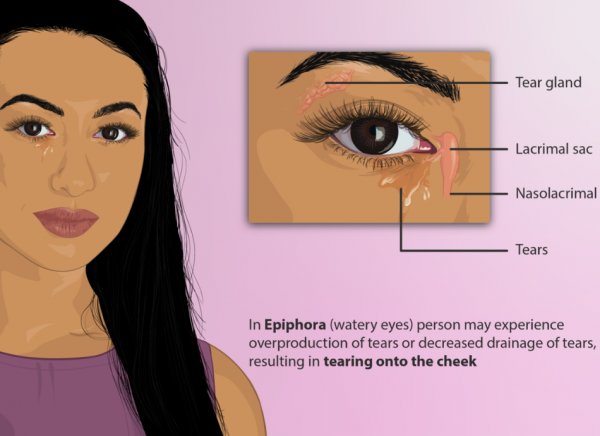Wishing everyone a safe and happy Christmas and New Year – Meri Kirihimete from the Healthify team.
Watery eye
Also known as epiphora
Key points about watery eye
- Tears are very important to the health of our eyes. But having too many tears, or watery eyes, may be frustrating or embarrassing. They could also cause vision problems.
- Watery eyes are commonly caused by the eye producing too many tears and/or poor drainage of the tears from the eye.
- Producing too many tears may be a response to eyelid inflammation, allergy or irritation.
- Poor tear drainage can be due to a physical problem with the eye's tear ducts and may require surgery.
- A range of treatments are available depending on the cause.

Your tears are composed of 3 layers – oil, water and mucous. The oily layer is produced by the meibomian glands which line the edge of the eyelids. The lacrimal gland, which sits just below the eyebrow produces the watery layer. The third layer comes from microscopic goblet cells in the conjunctiva.
To keep your eyes comfortable, a small volume of tears is continually produced. When your eyes are irritated or when you cry, a greater volume of tears are produced from larger glands near the outer corner of the eye.
Some of the fluid in the tear evaporates from the surface of the eye. The rest drains from the upper and lower eyelids near the nose through bony canals (known as nasolacrimal ducts or tear ducts) and into the nose. This is the reason you need to blow your nose when you cry!
This image shows the parts of the eye associated with tear production and drainage.

Image credit: myupchar via Wikimedia Commons(external link)
The main reasons for watery eye problems are:
- overproduction of tears (too many)
- poor drainage of tears
- a combination of both.
Too many tears
Overproduction of tears is usually due to irritation or inflammation of the surface of the eye. There are many potential causes but the commonest include:
- eyelid inflammation (blepharitis) or eyelid problems – where they turn inward (entropion) or outwards (ectropion)
- eyelash problems
- dry eye – if the surface of your eye is dry your body produces more tears to try and lubricate it
- allergies, eg, hay fever
- irritation from being in an environment that’s cold, windy or has very strong light.
Note that some overproduction of tears can be expected when you’re in the wind or you get something in your eye, but constant watering isn’t normal and should be looked into.
Treatment of tear overproduction involves identifying and relieving the cause. The treatments are usually non-surgical and may need to continue in the long term to control the underlying problem. Treatment could include antihistamines, antibiotics, warm compresses or massage if the excessive tears are due to an infection or an allergy.
Poor tear drainage
Again, there are many potential causes for poor or reduced tear drainage. These include:
- looseness of the lower eyelids causing the drainage system to fail
- narrow or displaced tear drainage openings.
- partial or complete blockage of the nasolacrimal duct (the bony canal that drains tears from the eyes).
Treatment of poor tear drainage is usually surgical. This may include:
- eyelid tightening
- opening of the puncta (tear drainage openings)
- surgery to remove an obstruction.
Surgery usually works well in improving watering problems due to poor tear drainage.
Depending on the cause, watery eyes may clear up by themselves. You can try using artificial tears or putting a warm compress on your eyes for a few minutes.
When to get help immediately
It’s important that you get medical attention immediately if you have watery eyes, and:
- reduced vision
- pain around your eyes
- it feels like there’s something in your eye (a foreign body).
When to see your healthcare provider or optometrist
If your watery eye problem continues and doesn’t clear up on its own, talk to your healthcare provider. They may be able to help you or can provide a referral to an eye specialist (ophthalmologist).
Occasionally, babies have a watery eye and this is usually due to a tear duct not being fully open in the first few months of life. It mostly fixes itself within the first year when the duct begins to work properly. If the problem doesn’t improve, or you’re worried, talk to your healthcare provider who can arrange for referral to an eye specialist if needed. If it continues after 12 months of age, a minor surgical intervention to open the duct might be needed.
Watery eyes(external link) Eye Institute Auckland NZ
Watery eye(external link) Auckland Eye
Watery eyes(external link) Mayo Foundation for Medical Education and Research, US
Watery eyes – when to see a doctor(external link) Mayo Foundation for Medical Education and Research, US
For further information contact your optometrist or ophthalmologist for individual assessment.
References
- Watery eyes(external link) Mayo Foundation for Medical Education and Research, US, 2022(external link)
- Watery eyes – when to see a doctor(external link) Mayo Foundation for Medical Education and Research, US, 2022
Credits: Healthify editorial team. Healthify is brought to you by Health Navigator Charitable Trust.
Reviewed by: Dr Divya Perumal, Opthalmologist, Auckland
Last reviewed:





